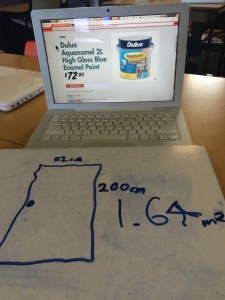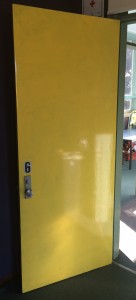This is a follow up project based learning experience to “Operation Sandbox’ completed earlier in the year and detailed in a previous blog. The focus on this activity was on mastering aspects of area while sandbox dived deeply into volume. The feedback from most (but not all) students on ‘Operation Sandbox’ was that they really enjoyed the exploration, creative learning and real life aspects of the project. It was challenging, and of course many aspects of the maths content will be revisited for consolidation and extension during future maths lessons.
Mt Ousley PS staff are focusing on improving the learning spaces in the school. It’s a standard 1960 building with corridors, square rooms, and some areas that are under utilised for learning. Teachers have been allocated a generous budget to partially refurbish their rooms with flexible seating, storage and display furnishings – exciting times!
As classes increasingly focus on differentiated learning and small group learning, we are seeing students working on the floor, in corridors, bagrooms, our blue room recording studio and outside. Being 1:1 laptop also encourages student self-paced, anytime anywhere learning. A makerspace is being developed, new playground equipment has been installed and students are also designing a new outdoor learning area.
As our class collaborated and discussed items that would benefit our learning space the idea of painting the three dull green doors was raised; a perfect opportunity to engage the students in authentic learning via maths and the topic of area. I allowed the class to work in groups of 2-4 and set the task.
‘How much paint will we need to buy from the hardware store to adequately paint the three doors?
That was my set up question that would lead to other questions such as –
What units of measurement will use?
How will we physically measure aspects of the door?
How many coats does each door need?
What colour does the class agree on?
With a stage two class I had a small number of students who could confidently attack the problem and the majority who required some scaffolding and support, mainly through encouragment and providing confirmation that they were on the right track with strategies and equipment.
Over a week we had three practical sessions exploring the measurement tool used; metre ruler, class ruler or tape measure. Students practised taking accurate measurements in metres or centimetres. Students in their groups then used known area strategies, Googled ‘area’ calculations or came to me for tutorials on area.
We had a check in and found that some groups had the correct answer, while two that had only allowed for one coat of paint and forget to double their answer. The tutorial group had worked through the solution with my assistance.
The class then jumped onto the Dulux paint website and looked at enamel colours before reading the paint specifics from a hardware website to see what size tin was required. This was a great lesson in art and primary/secondary colours as we talked about the emotions of colour and how they impact a learning space. A lengthy discussion was had until we selected on a bright yellow to counter our turquoise green carpet and walls.
Ideally I would have had the students paint the doors, however being enamel paint with strong fumes I decided against this. I did however have a few students give the doors a very light sand to get an idea of the preparation required. So with a one litre tin of bold yellow I’ve spent a couple of afternoons brightening up the room! 
 So to me, PBL is a fun way of making learning authentic, engaging and challenging in a supportive and friendly manner. While backward mapping and careful programming are the keys to ensuring a cohesive delivery of the maths syllabus scope.
So to me, PBL is a fun way of making learning authentic, engaging and challenging in a supportive and friendly manner. While backward mapping and careful programming are the keys to ensuring a cohesive delivery of the maths syllabus scope.
